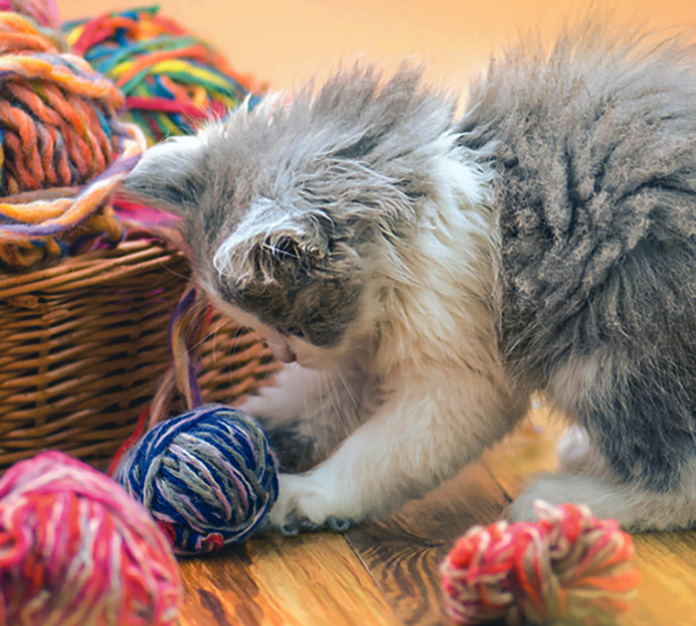Cats enjoy playing with bits of string and yarn, unravelling carefully rolled balls and batting at dangling ends. Unfortunately, though, this cute pastime can quickly develop into an emergency veterinary visit if the cat eats the string.
What’s the Big Deal?
Your cat’s digestive tract moves food along via a series of contractions. As muscles along the intestines contract in order, a wave-like motion called peristalsis is created, causing food to move along. If your cat just chomps down on a small piece of string, ribbon, or yarn, it will likely tag along on this peristaltic ride and pop out in your cat’s feces along with everything else that couldn’t be digested.
Trouble arises with longer strings, or if the string gets caught on something along the way. If one end of the string gets wrapped around your cat’s tongue or a tooth, that end becomes an anchor. The rest of the string can still move freely for a bit and will continue down your cat’s throat and into the stomach and intestines. As the intestines go through their normal contractions, each wave “grabs” at the string, but because the string can’t move forward, the intestines end up creeping backward up the string.
Over time, the intestines become bunched up, with the string getting pulled tighter and tighter. The bunching limits the ability of normal digestive processes and can result in an obstruction. Eventually the string gets tight enough that it starts to cut off the blood supply to parts of the intestines or to slice through the tissues. These complications quickly progress to necrosis, and perforation of the intestines can cause systemic shock and infection as the contents of the digestive tract spill into the abdomen.
Signs of an Obstruction
Unfortunately, we often don’t know when our cats have eaten something they shouldn’t (and your cat probably won’t confess). Signs of a potential intestinal obstruction include:
- Vomiting
- Inappetence
- Foul breath
- Repeated swallowing
- Diarrhea
- Decreased stool production
- Depression and lethargy
- Tender abdomen
If you cat is showing any of these signs, especially if you know that some string, yarn, or ribbon has gone missing, a veterinary visit is in order.
In some cases, your cat may not succeed in hiding the evidence of his crime. You may be able to see the string caught under his tongue, or it could even protrude from his anus after defecation. DO NOT tug on the string in either case! Depending how long the string is and where it ends, pulling on it could cause damage to the esophagus and/or intestines. Get help from your veterinarian.
Diagnosis
Any physical exam should include an oral exam, allowing your vet to check for any strings or other items stuck around his tongue or teeth. If you know or suspect that your cat has consumed string, a good look into his mouth will be essential. For some cats, this may require sedation.
Depending on your cat’s presenting symptoms, your veterinarian may also recommend:
- Bloodwork to check for signs of infection or systemic diseases that could cause similar symptoms
- Radiographs to check for blockages
- Ultrasound to evaluate the digestive tract for damage or obstruction
- Endoscopy to check the string’s length.
If your cat is in fairly good condition and there is no obvious sign of a string, you may be advised to monitor him. Medications can be prescribed to help with nausea, vomiting, and diarrhea. For cats that are caught in the act of swallowing a piece of string or related item, your vet may induce vomiting if you are able to get him in quickly.
If a string is found or there are signs of obstruction, surgery is often the recommended treatment.
Surgery
“Most owners think that it would be a routine intestinal surgery in order to extract the string,” says James Flanders, DVM, DACVS, Emeritus Associate Professor Section of Small Animal Surgery. “However, we always remind them that there is a chance that the string has sawn through the wall of the intestine and there may be peritonitis or the need to do a resection of damaged intestine.” The surgeon will carefully free sections of the string one at a time to prevent any further damage to your cat’s tissues. Depending on the length and location of the string, this may require several incisions in the intestines themselves.
The surgeon will also evaluate your cat’s entire intestinal tract to look for damaged tissue. If any section of the intestines has been cut off from its blood supply, the surgeon will remove the necrotic tissue and close the intestines back up so that there is only healthy tissue left behind. If there has been a perforation, the abdominal cavity will be flushed several times to clean it out. The extra care taken now could prevent your cat from needing a second surgery.
After surgery, your cat will need supportive care. “The string can really cause a lot of trauma to the stomach and the lining of the intestine as it rubs against the lining. We expect the cats to feel pretty crummy for a few days so they need some analgesia and sometimes some appetite stimulation,” says Dr. Flanders. “If the owner can get the cat to take some sucralfate then that helps to coat the stomach and makes them feel a bit better. We also may recommend Onsior (a non-steroidal anti-inflammatory drug) for a few days. If a cat has had an intestinal perforation, we will ususally prescribe antibiotics for one to two weeks to prevent or resolve infection.”
Prevention
The best way to prevent your kitty from ingesting string or yarn is to prevent access to these items unless your cat is under direct supervision.
The $64,000 Question:
Can I Just Cut the String?
CatWatch: Do you ever recommend that an owner cut the string, let the cat swallow the exposed end, and monitor the cat?
Dr. Flanders: If an owner could not afford the surgery then this might work. There is certainly a risk that the string will continue to do damage. However, there is a chance that it could pass if it does not get caught on anything during its passage through the entire intestinal tract.
When possible, have the string removed promptly before it has time to damage your cat’s digestive tract.



